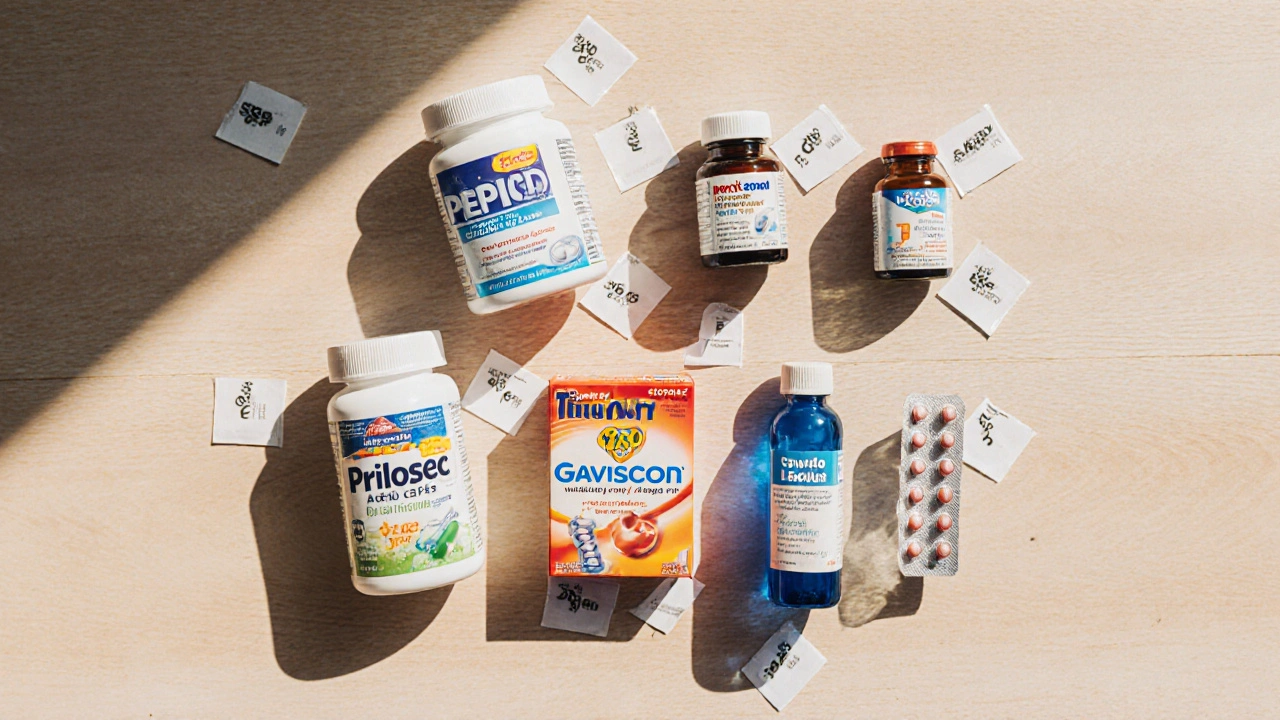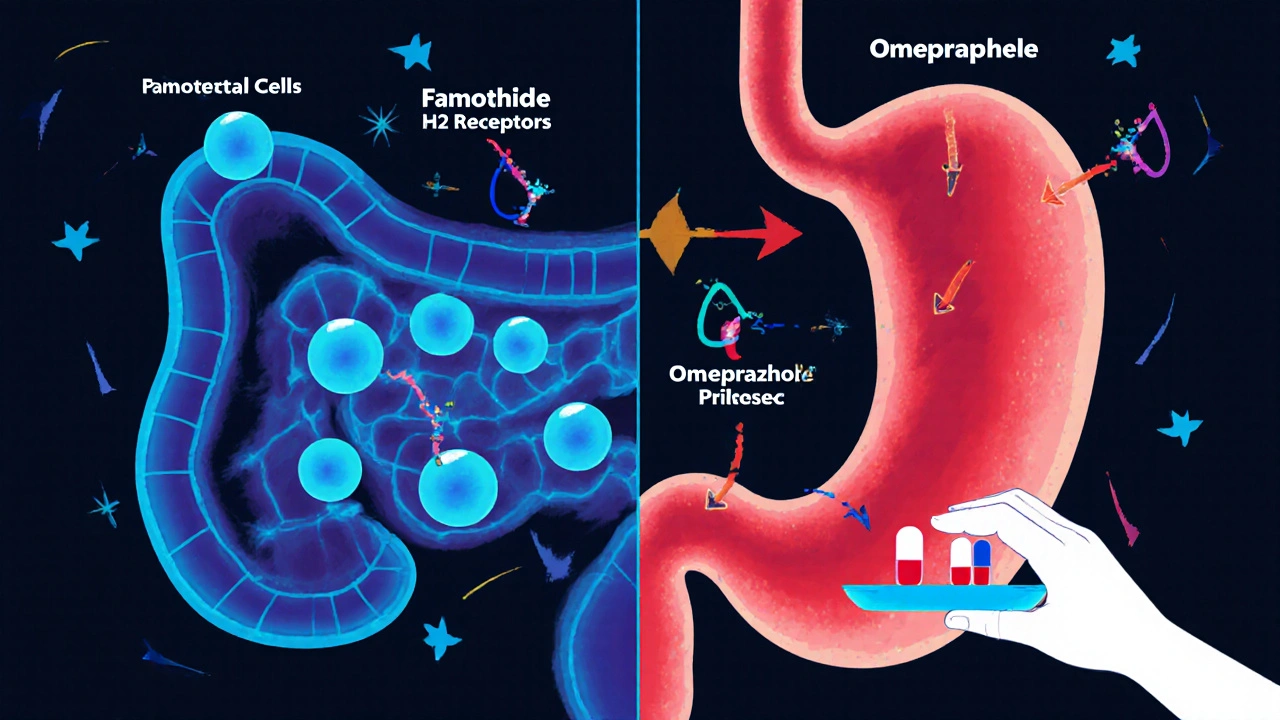Acid Reflux Medication Selector
Find Your Best Acid Reflux Relief
Answer a few quick questions to get personalized recommendations for your acid reflux treatment.
When heartburn or acid‑reflux symptoms keep you up at night, the first question you ask yourself is: "Which pill will actually calm my stomach?" Pepcid (famotidine) often tops the list, but a handful of other drugs claim the same relief. This guide breaks down the science, cost, safety and real‑world performance of Pepcid and its most common rivals so you can decide what fits your lifestyle and health profile.
Key Takeaways
- Pepcid (famotidine) is an H2‑receptor blocker that reduces stomach acid for up to 12hours.
- Proton‑pump inhibitors (PPIs) such as omeprazole and esomeprazole are stronger but work more slowly.
- Older H2 blockers like ranitidine are largely withdrawn in the UK, leaving famotidine as the primary option.
- Antacids (calcium carbonate, alginic acids) provide rapid relief but are short‑acting.
- Price, dosing convenience and side‑effect profile are the biggest differentiators for most users.
What is Pepcid (Famotidine)?
Pepcid is a brand name for famotidine, an H2‑receptor antagonist that blocks histamine‑driven acid secretion in the stomach. It was approved in the UK in 1995 and is available over‑the‑counter in 20mg and 40mg tablets. By inhibiting the H2 receptors on parietal cells, Pepcid cuts acid production by roughly 50‑70% and maintains relief for 8‑12hours after a single dose.
When might you reach for Pepcid?
Typical scenarios include:
- Mild‑to‑moderate heartburn that occurs after meals.
- Pre‑emptive dosing before a known trigger (e.g., a heavy dinner or alcohol).
- Short‑term treatment of gastric ulcers under doctor supervision.
- Situations where a rapid‑onset drug is needed but a full‑strength PPI feels excessive.
If symptoms are severe, persistent for more than two weeks, or accompanied by weight loss, you should see a GP before self‑medicating.

Other Popular Acid‑Reflux Options
Below are the main competitors you’ll encounter on pharmacy shelves or prescription lists in the UK.
Zantac (ranitidine) was historically the go‑to H2 blocker, but after 2020 most batches were recalled due to NDMA contamination. Although a few limited‑release formulations remain, famotidine has become the default H2 antagonist.
Prilosec (omeprazole) is a proton‑pump inhibitor (PPI) that blocks the final step of acid secretion, delivering up to 90% reduction in gastric acidity. It is sold OTC in 20mg capsules and requires daily dosing for maximum effect.
Nexium (esomeprazole) is a second‑generation PPI offering slightly longer half‑life and a smoother release profile, often preferred for night‑time reflux.
Tums (calcium carbonate) delivers immediate neutralisation of stomach acid. It works within minutes but the effect wanes after 30‑60minutes.
Gaviscon (alginic acid + sodium bicarbonate) forms a foam barrier that floats on top of the stomach contents, giving both neutralisation and physical protection.
Pepto‑Bismol (bismuth subsalicylate) offers mild antacid action and also coats the mucosa, useful for occasional indigestion.
Sucralfate (Carafate) creates a protective gel over ulcer sites, but is rarely used for simple heartburn.
Side‑by‑Side Comparison Table
| Drug | Class | Typical Dose & Frequency | Onset of Relief | Duration of Action | Effectiveness (Mild‑Moderate) | Common Side Effects | Typical OTC Price (GBP) |
|---|---|---|---|---|---|---|---|
| Pepcid | H2 blocker | 20mg - 1 tablet, once or twice daily | 30‑60min | 8‑12h | ≈80% | Headache, dizziness, occasional constipation | £2.50 (20mg pack of 12) |
| Prilosec | PPI | 20mg - 1 capsule daily | 1‑3h (full effect after 2‑3 days) | 24h | ≈95% | Diarrhoea, nausea, rare vitamin B12 deficiency | £3.00 (20mg pack of 14) |
| Nexium | PPI | 20mg - 1 capsule daily (or 40mg twice daily for severe cases) | 1‑3h | 24h | ≈96% | Headache, abdominal pain, potential long‑term bone density impact | £4.20 (pack of 14) |
| Tums | Antacid (calcium carbonate) | Chew 2‑4 tablets as needed | 5‑10min | 30‑60min | ≈60% | Gas, constipation, hypercalcaemia (rare) | £1.80 (pack of 36) |
| Gaviscon | Alginate‑based antacid | 10‑20ml after meals and at bedtime | 10‑15min | 2‑3h | ≈70% | Flatulence, mild taste disturbance | £2.20 (100ml bottle) |
| Pepto‑Bismol | Antacid & coating agent | 30ml liquid or 2 chewable tablets after meals | 15‑30min | 1‑2h | ≈65% | Black tongue, mild constipation | £2.80 (150ml bottle) |
| Sucralfate | Protective coating | 1g (1tablet) four times daily before meals | 2‑4h | 6‑8h | ≈80% for ulcer healing, low for simple reflux | Constipation, dry mouth | £5.50 (30‑tablet pack) |
Deep Dive: Pros and Cons of Each Option
Pepcid (famotidine)
- Pros: Fast onset, works on demand, inexpensive, low risk of long‑term nutrient deficiencies.
- Cons: Not as powerful as PPIs for severe erosive esophagitis; may need twice‑daily dosing for all‑day control.
Prilosec (omeprazole)
- Pros: Highest acid suppression, excellent for healing ulcers and severe GERD; once‑daily dosing.
- Cons: Takes several days to reach peak effect, possible interaction with clopidogrel, low‑grade nutrient absorption issues with long‑term use.
Nexium (esomeprazole)
- Pros: Slightly longer half‑life than omeprazole, better for night‑time symptoms.
- Cons: Similar cost to Prilosec, same long‑term safety considerations.
Tums (calcium carbonate)
- Pros: Immediate relief, also adds calcium to diet.
- Cons: Short‑acting, may cause gas or constipation, not suitable for chronic daily use.
Gaviscon (alginate)
- Pros: Provides a physical barrier, helpful for post‑meal reflux.
- Cons: Requires liquid formulation, taste may be off‑putting for some.
Pepto‑Bismol
- Pros: Dual action (neutralises acid and coats stomach), over‑the‑counter.
- Cons: Black stool/tongue can alarm users; contains salicylate-use cautiously if on anticoagulants.
Sucralfate
- Pros: Strong ulcer‑healing support, minimal systemic absorption.
- Cons: Requires multiple doses on empty stomach, not convenient for fast heartburn relief.

How Much Does It Cost in the UK?
Price is a quick filter for many shoppers. Below are typical retail prices for a standard size pack (as of October2025).
- Pepcid 20mg - £2.50 per 12‑tablet pack.
- Prilosec 20mg - £3.00 per 14‑capsule pack.
- Nexium 20mg - £4.20 per 14‑capsule pack.
- Tums chewables (500mg) - £1.80 per 36‑tablet pack.
- Gaviscon liquid - £2.20 per 100ml bottle.
- Pepto‑Bismol liquid - £2.80 per 150ml bottle.
- Sucralfate 1g - £5.50 per 30‑tablet pack.
Most NHS pharmacies will let you buy a 2‑week supply of Pepcid or a PPI without a prescription, while Sucralfate usually requires a doctor’s note.
Safety, Interactions and Who Should Avoid What
Even over‑the‑counter meds can clash with other drugs.
- Famotidine: Generally safe with antihypertensives and statins. Caution with didanosine (HIV medication) - may increase toxicity.
- Omeprazole / Esomeprazole: Reduces absorption of potassium‑sparing diuretics, certain antifungals (ketoconazole), and HIV protease inhibitors. Long‑term use may raise risk of Clostridioides difficile infection.
- Calcium carbonate (Tums): Can interfere with iron and certain antibiotics (e.g., tetracyclines). High calcium intake may affect kidney stone risk.
- Alginates (Gaviscon): Mostly benign, but sodium content may be an issue for people on low‑salt diets.
- Pepto‑Bismol: Avoid if you’re allergic to aspirin or take blood thinners; black stools are harmless but can be alarming.
- Sucralfate: Should not be taken with other oral meds within 30minutes because it can coat them and prevent absorption.
Pregnant or breastfeeding women should consult a GP before starting any of these, though famotidine is classified as Category B (no proven risk).
Choosing the Right Acid‑Reflux Tool for You
Use this simple decision tree:
- If you need instant relief after a big meal, start with Tums or Gaviscon.
- If symptoms are moderate, predictable and you want a pill you can take before dinner, try Pepcid 20mg 30minutes prior.
- If you suffer from severe or daily reflux that disrupts sleep, a daily PPI like Prilosec or Nexium is more effective.
- If you have an ulcer or erosive esophagitis confirmed by endoscopy, discuss a short course of a PPI plus protective agents (sucralfate) with your doctor.
- If you have kidney disease or are on multiple meds, favor famotidine because it has fewer drug‑interaction concerns than PPIs.
Always reassess after 2‑4 weeks-if heartburn persists, it’s time to seek medical advice.
Frequently Asked Questions
Can I take Pepcid and a PPI together?
Generally you don’t need both; the drugs work at different points in the acid‑production chain. Using them together can increase side‑effects without added benefit, so only combine them under a doctor’s guidance.
How long can I use Pepcid safely?
For most people, short‑term use (up to 8 weeks) is safe. If you find yourself reaching for it daily beyond that, talk to a GP about underlying causes and possibly switching to a PPI.
Is famotidine safe for older adults?
Yes, famotidine is often preferred for seniors because it has minimal impact on kidney function at standard doses and fewer interactions with common heart medications.
Why was ranitidine removed from the market?
Regulators found that some ranitidine batches contained the probable carcinogen NDMA above acceptable limits, prompting a worldwide recall. That’s why famotidine is now the main H2 blocker.
Can antacids replace a PPI for chronic GERD?
Antacids give quick but brief relief. For chronic GERD that needs sustained acid control, a PPI is typically more effective. Antacids can be used alongside a PPI for breakthrough symptoms.




Lief Larson
October 14 2025I swear Pepcid works faster than most PPIs for occasional heartburn when you take it before a big meal